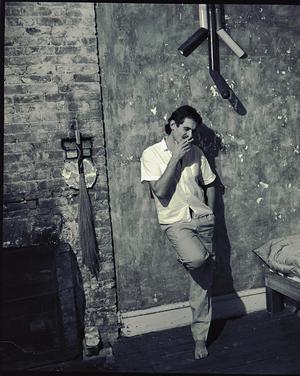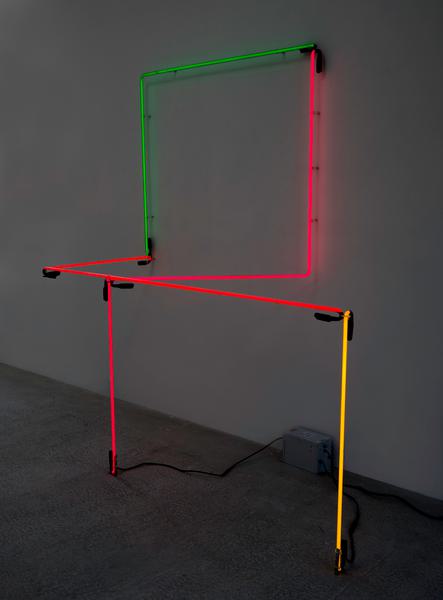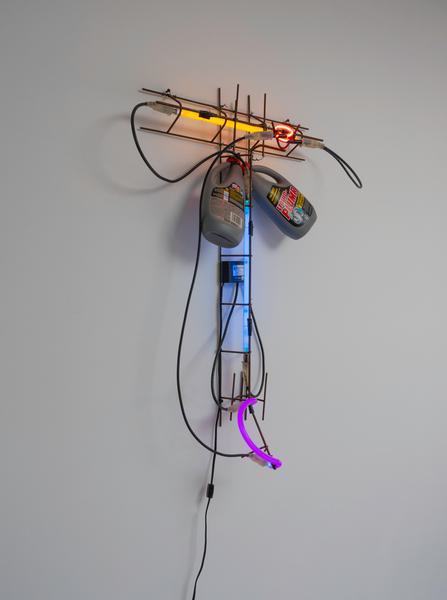Keith Sonnier
Keith Sonnier (1941-2020) was part of a group of artists who challenged preconceived notions of sculpture in the late 1960s by experimenting with industrial and ephemeral materials. His materials ranged from latex and satin, to found objects, transmitters and video. In 1968, the artist began creating wall sculptures using incandescent light and sheer fabric. Frustrated by the standardised forms of incandescent light, he started experimenting with neon. Using copper tubing as a template, Sonnier began sketching lines, arches and curves ultimately realised in neon. The linear quality of neon allowed Sonnier to draw in space with light and colour while coloured light interacted with the surrounding architecture.
Sonnier played a major part in the radical reinvention of sculpture in the late 1960s. Employing previously unusual materials, Sonnier, along with his contemporaries, Eva Hesse, Barry Le Va, Bruce Nauman, Richard Serra, Joel Shapiro, Richard Tuttle, and Jackie Winsor, called all previous conceptions of sculpture into question. Sonnier experimented with a wide range of materials and in 1968 began working with neon which quickly became a defining element of his work.
The artist has been the subject of more than 130 solo exhibitions and has participated in more than 360 group exhibitions throughout his career, including: Documenta 5, Kassel (1972); Keith Sonnier: Neon (1989) at the Hirshhorn Museum and Sculpture Garden, Washington, D.C.; Keith Sonnier: Porte Vue (1979) at Musée National d'Art Moderne, Centre Georges Pompidou, Paris; Projects: Keith Sonnier (1971) at the Museum of Modern Art, New York; the Venice Biennale (1972, 1982); the Whitney Museum of American Art’s 1970 Annual Exhibition: Contemporary American Sculpture, Biennial Exhibitions (1973, 1977), and The New Sculpture 1965 – 1975: Between Geometry and Gesture (1990) which later traveled to the Museum of Contemporary Art in Los Angeles.
Sonnier’s architectural neon installations in public spaces have earned him wide acclaim in an international context. More than 20 important public commissions by the artist have been realized since 1981. Included among these commissions is Lichtweg (or Lightway) at the New International Airport, Munich (1989-1992), a permanent installation that spans the 1,000 meter walkway of moving sidewalks, linking terminals and orienting passengers in a pathway of light. Additional installations include: Kansas City International Airport (2006); Munich Re Headquarters in Munich (2002); Pfarrexpositur St. Franziskus, Roman Catholic Church, Steyr, Austria (2002); Ronald Reagan Building and International Trade Center, Washington D.C. (1998); Bureau of the Census, Bowie, Maryland (1997); and the Miami International Airport (1996).
His work can be found in dozens of public and private collections worldwide, including the Hara Museum of Contemporary Art, Tokyo; Kaiser Wilhelm Museum, Krefeld, Germany; Kunstmuseum Liechtenstein, Vaduz; Kunstverein St. Gallen, Switzerland; Musée National d'Art Moderne, Centre Georges Pompidou, Paris; Museu d’Art Contemporani de Barcelona; Museum für Moderne Kunst, Frankfurt am Main; Museum of Contemporary Art, Los Angeles; Museum of Contemporary Art, San Diego; Museum Haus Lange, Krefeld, Germany; Museum of Modern Art, New York; National Gallery of Australia, Canberra; New Orleans Museum of Art, Louisiana; Parrish Art Museum, Water Mill; Smithsonian American Art Museum, Washington, D.C.; Sprengel Museum, Hannover, Germany; Städtisches Museum Abteiberg Monchengladbach, Germany; Stedelijik Museum, Amsterdam, and the Whitney Museum of American Art.
Available Artists
- Andre Carl
- Avery Milton
- Baldessari John
- Bell Larry
- Brice Lisa
- Crawford Brett
- Dadamaino
- Dávila Jose
- de Tollenaere Saskia
- Downing Thomas
- Dyson Julian
- Francis Sam
- Freud Lucian
- Gadsby Eric
- Gander Ryan
- Guston Philip
- Haring Keith
- Held Al
- Hockney David
- Hui Zhang
- Kapoor Anish
- Katz Alex
- Kelly Ellsworth
- Knifer Julije
- Kusama Yayoi
- Le Parc Julio
- Leciejewski Edgar
- Léger Fernand
- Levine Chris
- LeWitt Sol
- Lichtenstein Roy
- Mangold Robert
- Maripol
- Martin Agnes
- Martin Jason
- Martin Kenneth
- Mavignier Almir da Silva
- Miller Harland
- Morellet François
- Motherwell Robert
- Nadelman Elie
- Nemours Aurélie
- O'Donoghue Hughie
- Pettibone Richard
- Picasso Pablo
- Prehistoric Objects
- Prince Richard
- Quinn Marc
- Riley Bridget
- Ruscha Ed
- Scott William
- Shrigley David
- Smith Anj
- Smith Richard
- Smith David
- Sonnier Keith
- Soto Jesús Rafael
- Soulages Pierre
- Taller Popular de Serigrafía
- The Connor Brothers
- Turk Gavin
- Vasarely Victor
- Warhol Andy
- Wesselmann Tom
- Wood Jonas
- Wool Christopher


